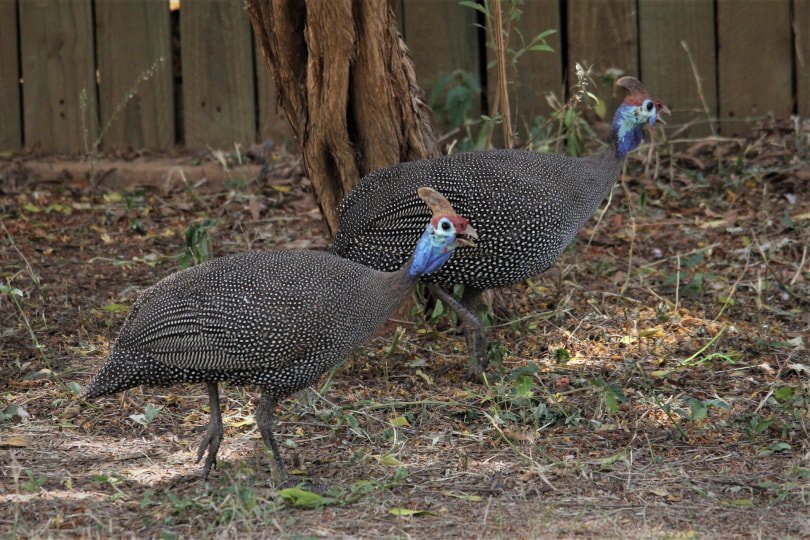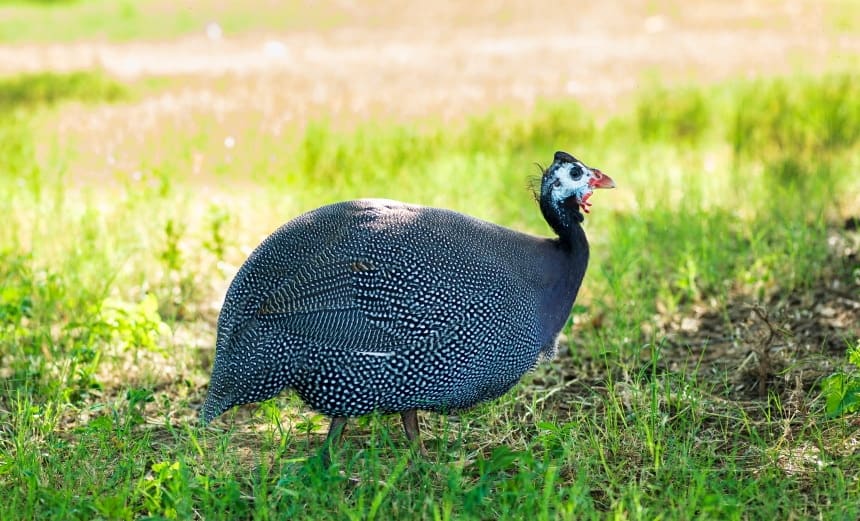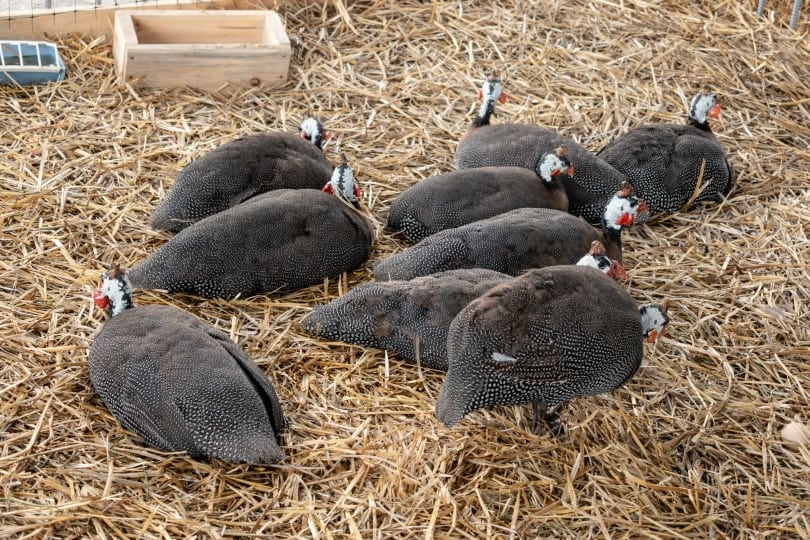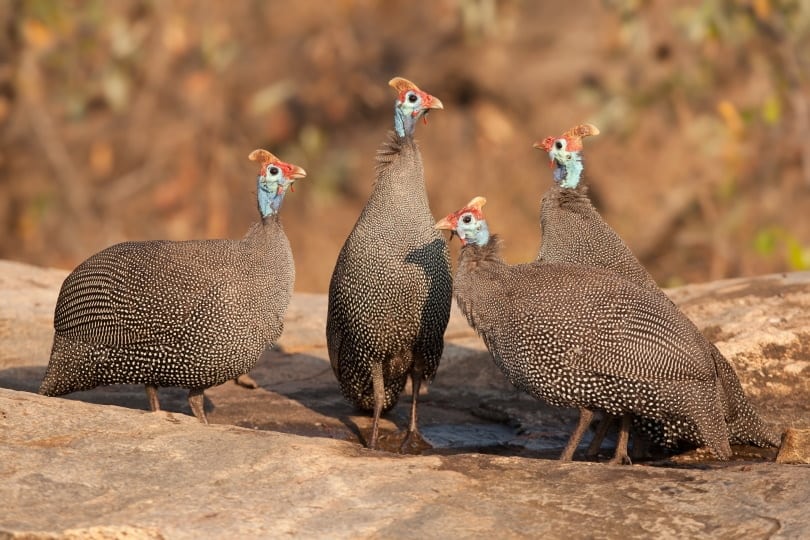Helmeted Guinea Fowls are native to Africa. Their bodies resemble those of partridges. These birds are found in many different settings in the wild, including savannah woodlands, dry thornbush, and agricultural areas. They choose areas to live in that can offer them easy access to water, dense brush for coverage, and trees where they can roost.
The Helmeted Guinea Fowl has a featherless head and face. The top of their head has a yellow or reddish bony, horn-like casque that gives them their helmeted name.
Though wild populations still exist, these birds are domesticated in various countries and raised for their meat and egg production.

Quick Facts About the Helmeted Guinea Fowl
| Breed Name: | Numida meleagris |
| Place of Origin: | Africa |
| Uses: | Pest control; meat and egg production |
| Guinea Cock (Male) Size: | 15–28 inches long; 1.9–3.8 pounds |
| Guinea Hen (Female) Size: | Often the same size and weight as males |
| Color: | Chocolate, pearl, purple, blue, white, grey, silver, pied, tan, ivory |
| Lifespan: | 10–15 years |
| Climate Tolerance: | Warm and dry, but adaptable to cold |
| Care Level: | Low |
| Egg Production: | 6–7 per week |
| Diet: | Omnivorous |
Helmeted Guinea Fowl Origins
Domesticated Helmeted Guinea Fowls originated from the wild species on the Guinea Coast of West Africa. In the late 15th century, the birds were introduced to Europe. Colonists then distributed them to other parts of the world, including North America.
Helmeted Guinea Fowls get their breed’s name, Numida meleagris, by combining the old Roman name for Africa (Numida) and meleagris, which means Guinea fowl. Finally, the casque on their head resembles a helmet.

Helmeted Guinea Fowl Characteristics
You will recognize these birds by their bald and brightly colored head holding a single horn-like casque. They have wattles around their nostrils. Each foot has three toes in the front and one in the back.
They can fly, but usually only for short distances. They prefer to walk or run anywhere they need to go or to escape danger.
During breeding season or if they feel threatened, they will let out a loud, harsh call. Males will often stand up to any threats or intruders by puffing up their feathers and raising their wings.
Helmeted Guinea Fowls are scavengers and use their beaks and feet to search for food in the soil. In the wild, they eat insects in the summer and seeds and bulbs in the winter.
They are social birds that live in large flocks. These flock members also help raise the young of different mothers. They work together to protect the flock from predators. In backyard flocks, the birds often warn of approaching egg-eating predators by letting out their loud, alarming call. They can scare off predators with these noises while simultaneously alerting their keepers.

Helmeted Guinea Fowl Uses
Today, Helmeted Guinea Fowl are raised as domestic birds. They’re popular among flock owners because they are hardy and easy to keep.
They are effective pest control. They’re used to control ticks, reducing the risk of Lyme disease to their keepers. They also have been known to kill and eat rodents, along with a host of other insects.
The birds are also kept for their egg and meat production. Their meat is described as tender, gamey, and lean. Their eggs can be used and eaten just like chicken eggs.
Helmeted Guinea Fowl Appearance & Varieties
Helmeted Guinea Fowls have large, round bodies. They have dark grey and black plumage that is spotted with white. Their bald heads and faces have a red, black, and blue coloring. They have rounded short wings and tails. While these birds can fly, they much prefer to walk or run away from any danger.

Several color variations can be seen in these birds. Common types include:
- Pearl Grey: The original color of the Helmeted Guinea Fowl
- Royal Purple: Dark-colored plumage that looks purple in the sunlight, with pearling on the wings
- Slate: Steel-grey plumage with cream highlights
- Violet: Similar to Royal Purple but without pearling
- Bronze: Reddish hue cast over the dark plumage
- Copper: Similar to bronze but with a violet vase
- Blonde: Soft brown color that is semi-spotted
- Ivory: Soft tan and white plumage with pearling
- Coral Blue: Soft blue color with blue feather edges and a few spots
Helmeted Guinea Fowl Population
The Helmeted Guinea Fowl population is not threatened. They have been introduced to Brazil, Australia, Europe, and the West Indies. They are also kept as domestic birds by flock owners in various countries, including North America.
The Handbook of the Birds of the World estimated that there are over 1,000,000 individuals worldwide. This species is classified as Least Concern on the IUCN Red List. The population numbers make the Helmeted Guinea Fowl a stable species.

Are Helmeted Guinea Fowls Good for Small-Scale Farming?
Helmeted Guinea Fowls are good for small-scale farming because they don’t require much in terms of their care. They are highly adaptable birds that get along with other birds. However, male Helmeted Guinea Fowls should not be kept with roosters. They get along well with chickens but will chase roosters to keep them away from the food and water sources.
While they may lay eggs often, female Helmeted Guinea Fowls are not great mothers. They tend to abandon their nests without any interest in hatching the eggs. If you’re looking to breed these birds, their eggs can be placed in the nests of other hens that will hatch and raise the keets, or baby Helmeted Guinea Fowls.
Even though Helmeted Guinea Fowl still exist in wild flocks today around the world, they have also become popular domesticated birds. They are commonly kept for eggs and meat. Their ability to adapt to different environments makes them easy to keep in backyard flocks around the United States.
See also:
Featured Image Credit: Sue Berry, Shutterstock
